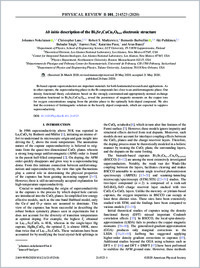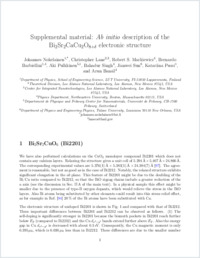Ab initio description of the ${\mathrm{Bi}}_{2}{\mathrm{Sr}}_{2}{\mathrm{CaCu}}_{2}{\mathrm{O}}_{8+{\delta}}$ electronic structure
- Nokelainen, Johannes Department of Physics, School of Engineering Science, LUT University, FI-53850 Lappeenranta, Finland
- Lane, Christopher Theoretical Division, Los Alamos National Laboratory, Los Alamos, New Mexico 87545, USA - Center for Integrated Nanotechnologies, Los Alamos National Laboratory, Los Alamos, New Mexico 87545, USA
- Markiewicz, Robert S. Physics Department, Northeastern University, Boston, Massachusetts 02115, USA
- Barbiellini, Bernardo Department of Physics, School of Engineering Science, LUT University, FI-53850 Lappeenranta, Finland - Physics Department, Northeastern University, Boston, Massachusetts 02115, USA
- Pulkkinen, Aki Département de Physique and Fribourg Center for Nanomaterials, Université de Fribourg, CH-1700 Fribourg, Switzerland - Department of Physics, School of Engineering Science, LUT University, FI-53850 Lappeenranta, Finland
- Singh, Bahadur Physics Department, Northeastern University, Boston, Massachusetts 02115, USA
- Sun, Jianwei Department of Physics and Engineering Physics, Tulane University, Louisiana 70118 New Orleans, USA
- Pussi, Katariina Department of Physics, School of Engineering Science, LUT University, FI-53850 Lappeenranta, Finland
- Bansil, Arun Physics Department, Northeastern University, Boston, Massachusetts 02115, USA
-
26.06.2020
Published in:
- Physical Review B. - 2020, vol. 101, no. 21, p. 214523
English
Bi-based cuprate superconductors are important materials for both fundamental research and applications. As in other cuprates, the superconducting phase in the Bi compounds lies close to an antiferromagnetic phase. Our density functional theory calculations based on the strongly-constrained-and- appropriately-normed exchange correlation functional in Bi2Sr2CaCu2O8+δ reveal the persistence of magnetic moments on the copper ions for oxygen concentrations ranging from the pristine phase to the optimally hole-doped compound. We also find the existence of ferrimagnetic solutions in the heavily doped compounds, which are expected to suppress superconductivity.
- Faculty
- Faculté des sciences et de médecine
- Department
- Département de Physique
- Language
-
- English
- Classification
- Physics
- License
-
License undefined
- Identifiers
-
- RERO DOC 328871
- DOI 10.1103/PhysRevB.101.214523
- Persistent URL
- https://folia.unifr.ch/unifr/documents/308751
Other files
Statistics
Document views: 115
File downloads:
- pdf: 216
- Supplementary material: 182

